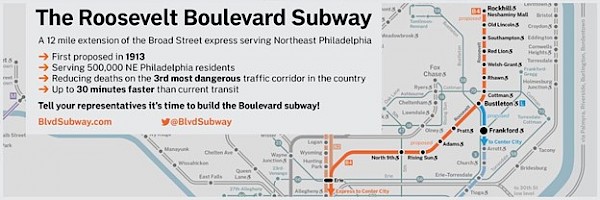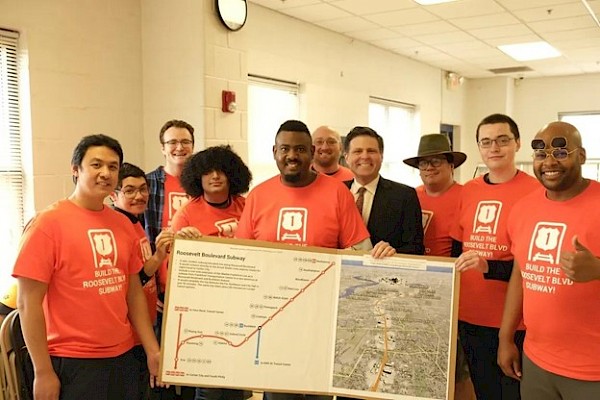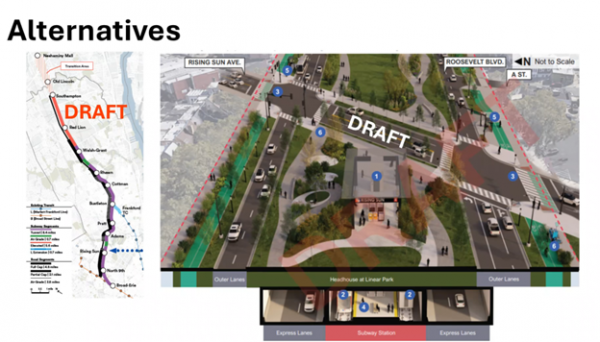Happening Now
[Guest Blog] Building the Roosevelt Boulevard Subway
December 6, 2024
From the team behind Build the Roosevelt Blvd Subway!
Introduction: A Century of Unrealized Ambition
The Roosevelt Boulevard Subway, also known as the Northeast Line, represents one of Philadelphia’s most enduring transit ambitions. First proposed in 1913 as part of a visionary plan to create a comprehensive rapid transit system, this project aimed to connect the rapidly growing neighborhoods of Northeast Philadelphia to Center City and beyond. At its inception, the subway was poised to transform the region, reducing travel times, catalyzing urban development, and addressing the need for efficient mass transit.

Over the decades, the potential of the Roosevelt Boulevard Subway has remained a tantalizing prospect, with successive advocates emphasizing its transformative impact on mobility, equity, and urban resilience. Early reports, such as the 1913 Report of the Transit Commissioner, underscored the project’s necessity in accommodating Philadelphia’s burgeoning population while reflecting the progressive urban planning ideals of the time. Despite these promises, over 111 years of political, financial, and logistical challenges have prevented the subway from materializing.
Today, the conversation surrounding the Roosevelt Boulevard Subway has gained renewed momentum, driven by urgent modern challenges such as traffic congestion, environmental sustainability, and systemic inequities in transportation access. Current Initiatives like PennDOT’s Roosevelt Boulevard Reimagined signal a critical opportunity to reassess and prioritize this long-delayed project. However, realizing its potential will require addressing systemic cost inefficiencies, leveraging innovative construction techniques, and aligning the project with the community’s evolving needs.
A Century of Unrealized Potential
The Roosevelt Boulevard Subway was conceived during a period of rapid urban expansion when Philadelphia’s planners sought to create a transit system that would serve the city's growing population. Early studies demonstrated the subway’s ability to significantly reduce travel times, integrate with regional transit systems, and enhance accessibility for underserved communities. Despite being included in various plans throughout the 20th century, the project was repeatedly sidelined by competing priorities, such as highway construction and other transit projects.
Northeast Philadelphia, with a population exceeding 400,000, has faced a longstanding lack of efficient transit options. Both historical records and recent community outreach underscore the sustained and growing demand for a subway that offers seamless, direct connections to Center City, South Philadelphia, and other key destinations. Despite this, progress remains stalled, with PennDOT projecting the start of construction no earlier than 2040. This delay underscores the pressing need to expedite progress and overcome the persistent barriers to realizing this vital infrastructure.
Recent Advocacy and Momentum
In 2022, State Representative Jared Solomon (D, District 202) spearheaded a series of town halls in Northeast Philadelphia, focusing on the future of the Roosevelt Boulevard Subway. These events revealed overwhelming community support for the subway, with residents emphasizing the transformative opportunities it would unlock. Improved access to jobs, schools, and recreation, coupled with economic development potential and neighborhood revitalization, were key themes.

On June 11, 2023, the collapse of an I-95 overpass in Northeast Philadelphia underscored the fragility of the region’s infrastructure. This event, which crippled transit across the Northeast Corridor, prompted swift action from local and state leaders. Within days, Philadelphia City Councilmember Driscoll introduced Resolution 230533, authorizing hearings to address the city’s transportation priorities. Governor Josh Shapiro highlighted the success of rapid, collaborative efforts to reopen I-95, positioning the Roosevelt Boulevard Subway as a similar opportunity for transformative action.
Throughout the summer of 2023, a series of briefings brought together officials from SEPTA, PennDOT, and other local and federal stakeholders. These meetings, which emphasized collaboration and innovation, provided a foundation for tackling the subway’s significant challenges, particularly its funding gaps.
The Case for the Roosevelt Boulevard Subway
Transformative Potential
The Roosevelt Boulevard corridor is home to a population that relies heavily on transit yet remains underserved by current infrastructure. The corridor’s existing bus routes are hampered by slow speeds, overcrowding, and inconsistent service. A subway would not only provide high-capacity, reliable transit but also offer a one-seat ride to critical destinations such as Center City and South Philadelphia stadiums.

Projections estimate daily ridership of 62,000 under the "Neighborhood Boulevard" scenario, highlighting the subway’s potential to become a cornerstone of Philadelphia’s transit system.
Sustainability
For a region where 24% of households lack access to a car, the subway represents a lifeline to jobs, education, and healthcare. By reducing dependence on automobiles, the project aligns with broader sustainability goals, including lowering greenhouse gas emissions and fostering transit-oriented development. These outcomes are critical for addressing social and environmental inequities, positioning the Roosevelt Boulevard Subway as a model for equitable urban growth.
Overcoming Obstacles: Lessons from History and Modern Solutions
Cost and Construction Efficiencies
One of the most significant barriers to the subway’s realization is its projected cost, currently estimated at $11 billion. Traditional tunnel-boring machine (TBM) methods, while effective in certain contexts, are poorly suited for the wide medians of Roosevelt Boulevard. Adopting cut-and-cover construction methods, coupled with prefabricated modules, offers a viable alternative. Cities like Madrid have successfully utilized these techniques to deliver cost-effective, high-quality transit infrastructure, providing a blueprint for Philadelphia.

Innovative Funding Mechanisms
Securing funding for the subway will require creativity and collaboration. While federal infrastructure programs offer substantial support, local funding mechanisms—such as value capture, public-private partnerships, and air rights leasing—must be explored to close funding gaps. Chicago’s recent success in securing $1.97 billion for the Red Line extension demonstrates the importance of leveraging diverse funding sources and building strong coalitions of local, state, and federal stakeholders.
A compelling example of this approach is the funding strategy for the Bay Area Rapid Transit (BART) Silicon Valley Phase II Extension. This ambitious project aims to add six miles and four stations to the BART system, including a 5.5-mile single-bore tunnel through San Jose and Santa Clara. In August 2024, the Federal Transit Administration committed $5.1 billion to the project through a New Starts capital investment grant, marking the second-largest federal grant ever awarded for a transportation initiative.
This multifaceted funding strategy underscores the necessity of combining federal assistance with local and state resources and innovative financing mechanisms to realize large-scale transit projects. The BART Silicon Valley Phase II Extension exemplifies how diverse funding sources and strong stakeholder collaboration are essential to advancing transformative infrastructure initiatives.
A Contemporary Opportunity
The Roosevelt Boulevard Subway represents more than a transit project it is a symbol of Philadelphia’s potential to deliver transformative infrastructure that addresses the needs of its residents. By embracing innovative construction methods, exploring diverse funding mechanisms, and fostering deep community engagement, the city can finally bring this century-old vision to life.
For Northeast Philadelphia, the stakes could not be higher. The subway promises improved mobility, enhanced equity, and sustainable urban growth. By acting decisively, Philadelphia can transform Roosevelt Boulevard from a "Corridor of Death" into a "Corridor of Opportunity," proving that bold planning and collective action can turn even the most ambitious dreams into reality.
----
If you have a project you would like to highlight through a guest blog here on our website and in the weekly Hotline, please email our Director of Community Engagement & Organizing Joe Aiello at [email protected] for details.
"We would not be in the position we’re in if it weren’t for the advocacy of so many of you, over a long period of time, who have believed in passenger rail, and believe that passenger rail should really be a part of America’s intermodal transportation system."
Secretary Ray LaHood, U.S. Department of Transportation
2011 Spring Council Meeting
Comments